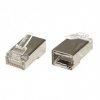1) I was wondering how you would protect the following setup against lightning:

The following devices are going to be connected to the PoE switch:
- one indoor camera
- two outdoor cameras (obviously more susceptible than the indoor camera)
- three PCs
The PoE switch is going to be connected to a power outlet that unfortunately doesn't have grounding, so only the line and neutral line are connected to the switch. (there is grounding available in our house, but I believe only in the bathroom and kitchen)
2) I was also wondering which devices would possibly be damaged by lightning if you set it up without any protection.
3) My last question is which type of cable is sufficient to the setup above. I'm doubting between cat 5e shielded vs unshielded.

The following devices are going to be connected to the PoE switch:
- one indoor camera
- two outdoor cameras (obviously more susceptible than the indoor camera)
- three PCs
The PoE switch is going to be connected to a power outlet that unfortunately doesn't have grounding, so only the line and neutral line are connected to the switch. (there is grounding available in our house, but I believe only in the bathroom and kitchen)
2) I was also wondering which devices would possibly be damaged by lightning if you set it up without any protection.
3) My last question is which type of cable is sufficient to the setup above. I'm doubting between cat 5e shielded vs unshielded.







